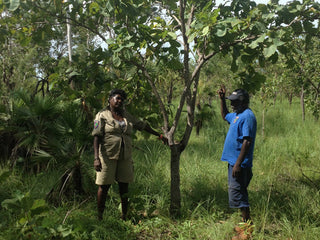Picture this: a small, green fruit, hidden away in the rugged landscapes of Northern Australia, suddenly becomes the talk of health food stores from Sydney to San Francisco. Sounds like the plot of a far-fetched movie, right?
Well, buckle up, because the Kakadu plum is taking us on a wild ride from the Australian bush to the global superfood stage – and it's bringing entire communities along for the journey.
Key Takeaways
| What is Kakadu plum? | Native Australian superfruit with exceptional nutritional properties |
|---|---|
| Traditional Use | Bushfood and medicine in Aboriginal culture for thousands of years |
| Modern Popularity | Growing global demand as a superfood and ingredient |
| Aboriginal Women's Role | Central to harvesting, processing, and knowledge preservation |
| Community Impact | Economic opportunities, cultural preservation, empowerment |
| Supply Chain | Wild harvesting to global distribution, challenges and innovations |
| Sustainability | Balancing increased demand with traditional practices |

Introduction: A Superfruit's Extraordinary Journey
As a naturopath with over 10 years of experience in integrative medicine and a deep passion for sustainable health solutions, I've seen my fair share of "miracle" foods come and go. But the Kakadu plum? It's not just another passing fad. This little powerhouse is rewriting the script on how we think about superfoods, Indigenous knowledge, and community empowerment.
What on Earth is a Kakadu Plum?
Alright, let's start with the basics. The Kakadu plum, or Terminalia ferdinandiana if you're feeling fancy, is a small fruit native to Northern Australia. It's been a staple in Aboriginal diets and traditional medicine for thousands of years. But here's where it gets interesting:
- It's the world's richest natural source of vitamin C (we're talking up to 100 times more than oranges!)
- Packed with antioxidants that make blueberries look like amateurs
- Loaded with ellagic acid, known for its anti-inflammatory properties
But trust me, the Kakadu plum's impressive nutrient profile is just the beginning of its story.

From Bush Tucker to Global Superfood: The Kakadu Plum's Incredible Journey
Now, you might be wondering, "How does a fruit go from bush tucker to global superfood?" Well, grab a cuppa, because this is where the story gets really good.
Ancient Wisdom Meets Modern Science
For thousands of years, Aboriginal people have known about the Kakadu plum's special properties. They've used it as food, medicine, and even as a natural preservative. But it wasn't until relatively recently that modern science caught up.
- 1980s: Scientists discover the Kakadu plum's exceptionally high vitamin C content
- 1990s-2000s: Research reveals other beneficial compounds, sparking interest in health and beauty industries
- 2010s onwards: Global demand for Kakadu plum products begins to soar
The Bush Harvest: Where It All Begins
Here's where the rubber meets the road – or should I say, where the boots hit the bush. Kakadu plum harvesting is still largely a wild endeavor, and this is where Aboriginal women take center stage.
- Traditional Knowledge: Aboriginal women are often the custodians of plant knowledge, including when and how to harvest
- Seasonal Work: Harvesting typically happens during the dry season (May to September)
- Community Effort: Entire families and communities often participate in the harvest
From Tree to Market: The Supply Chain Challenge
Getting Kakadu plum from remote bushland to global markets isn't exactly a walk in the park. It involves:
- Harvesting: Hand-picking fruit from wild trees
- Initial Processing: Cleaning and sorting the fruit
- Preservation: Freezing or drying to maintain freshness
- Transportation: Moving product from remote areas to processing facilities
- Further Processing: Creating powders, extracts, or other forms
- Distribution: Getting products to manufacturers or directly to consumers
Each step presents its own challenges, from logistics in remote areas to maintaining quality control. But innovative Aboriginal-owned businesses are rising to meet these challenges head-on.
Premium KAKADU PLUM Powder Wild Australian Superfood
This native Australian fruit boasts the highest recorded levels of Vitamin C, containing over 100 times the amount found in oranges!
View NowGUT OPTIMAX Health Superfood Powder 65g - Slippery Elm, Aloe Vera.
Gut Optimax is a powerful, food-based prebiotic blend formulated by our naturopath to help you achieve optimal gut health.
View NowThe Powerhouses Behind the Plum: Aboriginal Women Leading the Way
Now, let's talk about the real MVPs of the Kakadu plum industry – Aboriginal women. They're not just participants in this booming trade; they're the driving force behind it.
Guardians of Knowledge
Aboriginal women have been the traditional custodians of plant knowledge for generations. This includes:
- Understanding the Kakadu plum's lifecycle and optimal harvesting times
- Knowledge of traditional uses and preparation methods
- Sustainable harvesting practices that ensure the plants' long-term survival
From Harvesters to Entrepreneurs
But these women aren't just out in the bush picking fruit. They're:
- Starting and running Kakadu plum enterprises
- Developing new products and markets
- Sharing their culture and knowledge with a global audience
Empowering Communities
The impact of women's involvement in the Kakadu plum industry goes beyond individual success stories. It's about:
- Creating flexible employment opportunities that align with cultural obligations
- Providing role models for younger generations
- Strengthening connections to country and culture
Community Transformation: More Than Just Economics
The Kakadu plum boom isn't just about creating jobs or generating income (although those are certainly important). It's sparking a broader revitalization in many Aboriginal communities.
Economic Opportunities
- Stable Income: Seasonal work that complements other economic activities
- Business Ownership: Growth of Aboriginal-owned Kakadu plum enterprises
- Skills Development: Training in everything from sustainable harvesting to marketing and business management
Cultural Preservation
- Language: Use of traditional names and terms in product marketing
- Knowledge Transfer: Intergenerational sharing of plant knowledge and cultural practices
- Land Connection: Strengthening ties to traditional lands through harvesting activities
Community Wellbeing
- Pride: Seeing traditional knowledge valued on a global scale
- Health: Increased access to and awareness of nutritious traditional foods
- Education: Opportunities for young people to learn both traditional and modern skills
Challenges and Opportunities: Navigating the Path Forward
Of course, the journey from bush to global markets isn't without its bumps. The Kakadu plum industry faces some significant challenges:
Sustainability Concerns
- Wild Harvesting: Ensuring harvesting practices remain sustainable as demand grows
- Climate Change: Potential impacts on Kakadu plum populations and harvest seasons
- Land Management: Balancing commercial interests with traditional land care practices
Market Pressures
- Quality Control: Maintaining consistent quality in wild-harvested products
- Competition: Standing out in an increasingly crowded superfood market
- Regulation: Navigating food safety and export regulations
Cultural Protection
- Intellectual Property: Ensuring Aboriginal communities benefit from their traditional knowledge
- Appropriation: Preventing misuse or misrepresentation of cultural stories and practices
- Benefit Sharing: Developing fair and equitable models for profit sharing
But with these challenges come opportunities:
- Research and Innovation: Developing new Kakadu plum products and applications
- Sustainable Cultivation: Exploring ways to cultivate Kakadu plum while respecting traditional practices
- Indigenous-Led Enterprises: Growing Aboriginal-owned businesses across the entire supply chain
- Education and Tourism: Sharing Kakadu plum's story to promote cultural understanding
Q&A: Your Burning Kakadu Plum Questions Answered
Q: Is wild harvesting Kakadu plum sustainable?
A: When done properly, yes. Aboriginal communities have been harvesting Kakadu plum sustainably for thousands of years. However, as demand grows, careful management and potentially supplemental cultivation may be necessary.
Q: How can I be sure I'm buying ethically sourced Kakadu plum products?
A: Look for products from Aboriginal-owned businesses or those with clear partnerships with Aboriginal communities. Certifications from organizations like Supply Nation can also be a good indicator.
Q: What's the best way to use Kakadu plum?
A: Kakadu plum is available in various forms – powders, supplements, and in skincare products. Try adding the powder to smoothies, sprinkling it on yogurt, or look for skincare products that feature it as an ingredient.
The Future of Kakadu Plum: A Model for Ethical Superfoods?
As we look to the future, the Kakadu plum industry has the potential to become a shining example of how traditional foods can be brought to the global market in a way that benefits Indigenous communities and supports cultural preservation.
Some exciting developments to watch:
- Community-Owned Processing: Initiatives to establish processing facilities in remote communities, adding value locally
- Bush Food Education: Programs teaching both traditional knowledge and modern business skills to younger generations
- Kakadu Plum Tourism: Opportunities for cultural tourism centered around Kakadu plum harvesting and use
- Collaborative Research: Partnerships between Aboriginal communities and scientists to further explore Kakadu plum's potential
Wrapping It Up: A Small Fruit with Big Impact
So there you have it, folks. The journey of the Kakadu plum from bush to global superfood is more than just a great business story – it's a powerful example of how traditional knowledge, environmental stewardship, and ethical business practices can come together to create positive change.
As a naturopath, I'm excited about the health benefits of Kakadu plum. But as someone committed to holistic wellbeing – for individuals, communities, and the planet – I'm even more inspired by its potential to drive meaningful social and economic transformation in Aboriginal communities.
Next time you see a Kakadu plum product on the shelf, remember: you're not just buying a superfood. You're participating in a story of cultural preservation, women's empowerment, and sustainable development. And in my book, that's the kind of nourishment we could all use a little more of in our lives.
So go ahead, give Kakadu plum a try. Your body will thank you – and so will the communities who've been guardians of this remarkable fruit for thousands of years.









